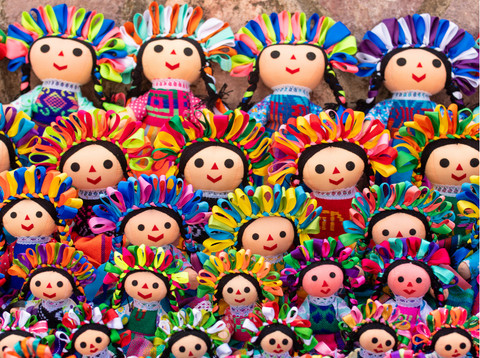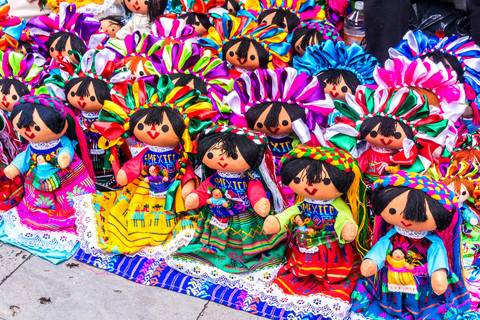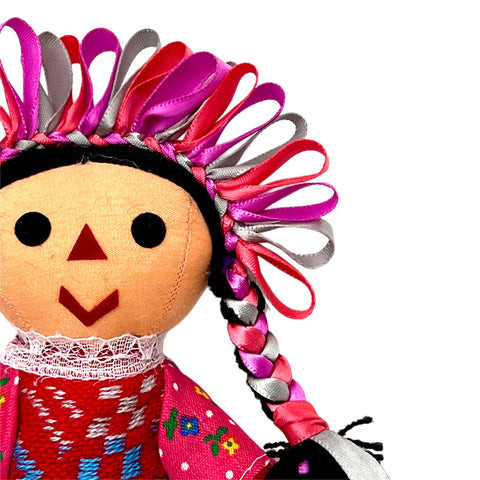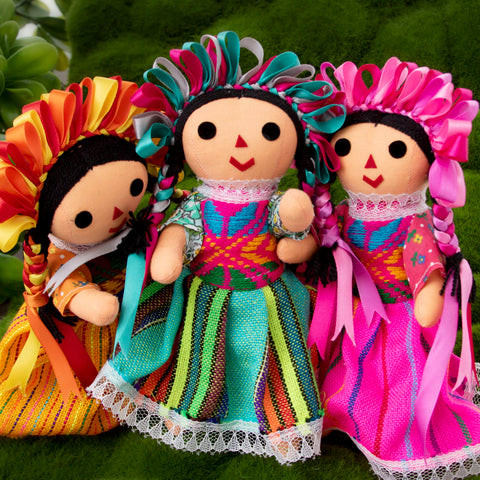The Mexican Doll, known affectionately as the Lelé doll, María doll, or Queretana doll, is a vibrant emblem of Mexican artistry and culture. Handcrafted with love by skilled Mexican artisans, these cloth dolls, adorned with traditional outfits, braids, and colorful ribbons, are instantly recognizable. But the mexican doll is much more than just a charming toy; it’s a symbol of national pride and indigenous heritage that resonates worldwide.
At gaymexico.net, we delve into the heart of Mexico’s rich cultural tapestry. Today, we celebrate the iconic mexican doll, exploring its origins, the intricate process of its creation, and the profound meaning it carries. Join us on a journey to uncover the story behind the Lelé doll, a quintessential craft from Queretaro that has captured hearts and gained international acclaim.
 A close-up of a Lelé doll's face, showcasing its embroidered smile and colorful ribbons
A close-up of a Lelé doll's face, showcasing its embroidered smile and colorful ribbons
What Exactly is a Lelé Doll? Unpacking the Charm of this Mexican Icon
“Lelé” is an Otomí word meaning “baby,” perfectly encapsulating the tender essence of this handcrafted treasure. Therefore, the mexican doll Lelé is essentially a “baby doll” in the truest sense. Distinguished by her long braids embellished with vibrant crowns and ribbons, and dressed in traditional attire, the Lelé doll proudly reflects the heritage of her creators: the indigenous Otomí, or Hñañu, people of Mexico.
Born in the Magic Town of Amealco, nestled in the state of Querétaro, this delightful and colorful mexican doll is the creation of artisans from the communities of Santiago de Mexquititlán and San Ildefonso Tultepec. This cherished art form has been lovingly passed down through generations, preserving the cultural identity and artistic spirit of these communities.
 A group of Lelé dolls in various sizes and colors, showcasing their traditional dresses and braids
A group of Lelé dolls in various sizes and colors, showcasing their traditional dresses and braids
The Historical Roots of the Mexican Doll: From Ancient Traditions to Modern Icon
The Lelé doll’s origin story is a fascinating blend of pre-Hispanic customs and Spanish influences. While today’s mexican doll is crafted from fabric and adorned with ribbons, it is believed that the earliest iterations were fashioned from natural materials like clay, palm, and corn fibers for hair. Ancient traditions suggest these early dolls were placed in children’s graves, intended to protect deceased children from malevolent spirits.
With the arrival of the Spanish, these dolls evolved. They became a charming and affordable alternative to imported European toys, particularly porcelain dolls, which were expensive and inaccessible to many. The mexican doll thus emerged as a beloved traditional toy for girls within Queretaro’s indigenous communities. Mothers and grandmothers poured their love into creating these dolls, passing down the art of crafting the Queretaro doll using cambaya fabrics, colorful ribbons, and black yarn through countless generations.
From Local Craft to Global Sensation: The Rise of the Iconic Mexican Doll
Initially a craft cherished within local communities, the mexican doll embarked on a journey to become a recognized symbol of Mexican artistry. This transformation began when nearly 10,000 Hñañu (Otomí) artisans from Amealco united to form a cooperative. Their collective effort and dedication propelled the Lelé doll into the spotlight. Increased media attention and the burgeoning power of social media further amplified the doll’s popularity and sales.
This heritage craft, nurtured across generations, now serves as a vital source of income for numerous families. The creation of each mexican doll is a completely handmade process, almost a sacred ritual for its artisans. The Lelé doll’s cultural significance was officially recognized when it was declared a Cultural Heritage of Querétaro and an Intangible Heritage of Humanity in 2018. A testament to its global appeal, a giant Lelé doll has toured the world, gracing cities like London, Shanghai, and Sydney, captivating audiences worldwide. A museum dedicated to the mexican doll even stands in Amealco De Bonfil, Querétaro, its birthplace, further solidifying its iconic status.
 A detailed shot of a small Lelé doll showcasing its traditional clothing and embroidered details
A detailed shot of a small Lelé doll showcasing its traditional clothing and embroidered details
The Art of Crafting a Mexican Doll: A Deep Dive into the Handmade Process
The renowned Lelé, the Amealco mexican doll, is a testament to the beauty of 100% handmade craftsmanship. The process begins with shaping the doll’s cloth body. For her iconic dress, artisans utilize poplin fabric (cambaya fabric), lace, yarn, and an array of vibrant ribbons. The doll’s clothing is a miniature reflection of the traditional attire worn by Hñañu (Otomí) women in each region, showcasing the diversity within their cultural expression.
Here are some key details that define the Lelé doll’s distinctive clothing:
Mirroring her creators, the Lelé doll is dressed in a long-sleeved blouse adorned with intricate, colorful woven patterns. The blouse’s chest area features traditional motifs and is often embellished with delicate lace around the neckline. Sometimes, satin or textured decorations add an extra touch of elegance. The instantly recognizable colorful skirts are crafted with lines of poplin fabric and finished with lace at the hem.
The dolls’ distinctive hairstyle is equally iconic. Lelé’s hair is styled in two prominent braids, interwoven with colorful ribbons that gracefully frame her face. Her face radiates Mexican warmth and joy, typically featuring a wide smile that is either embroidered or created with carefully glued fabric applications. Finally, an authentic mexican doll Lelé always wears a baby diaper; this essential accessory reinforces her identity as a baby doll. Always check for this detail to ensure you are admiring a truly authentic Lelé!
 A close-up image highlighting the details of a Lelé doll's traditional clothing and braided hair
A close-up image highlighting the details of a Lelé doll's traditional clothing and braided hair
The endearing figure of this little mexican doll has captured the hearts of Mexicans and tourists alike. However, the artisans who create these treasures face a significant challenge: the proliferation of counterfeit dolls produced in China. To support authentic craftsmanship and preserve this cultural heritage, it is crucial to purchase Lelé dolls directly from the artisans or from recognized craft stores.
The growing popularity of the mexican doll has made it a sought-after keepsake. Knowing that each doll is lovingly handmade by talented artisans from Queretaro makes owning a Lelé even more special. Like many exquisite handicrafts, creating a Lelé doll requires time and dedication. Crafting a small doll can take one to two days, while the larger, more elaborate pieces can take up to six days to complete!
We can all agree that Mexican handicrafts possess a unique charm, and the Hñañu (Otomí) Lelé doll stands as a shining example of the enchanting beauty and cultural richness of Mexican artistry that captivates the world.
Were you already acquainted with the Lelé Doll? Do you already own one, or are you now inspired to welcome one into your home? Share your thoughts and feelings about this delightful mexican doll in the comments below – we always appreciate hearing from you!
And be sure to explore our mercadito, where you can discover authentic Lelé dolls and other Lelé-inspired treasures. Don’t forget to subscribe to our newsletter for more fascinating insights into Mexican culture and artisanal traditions.

